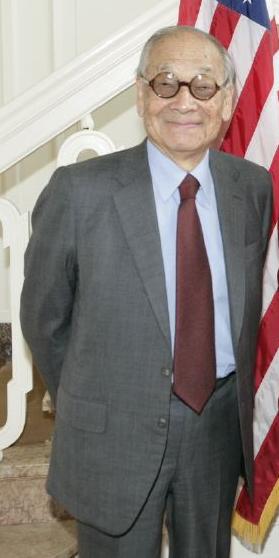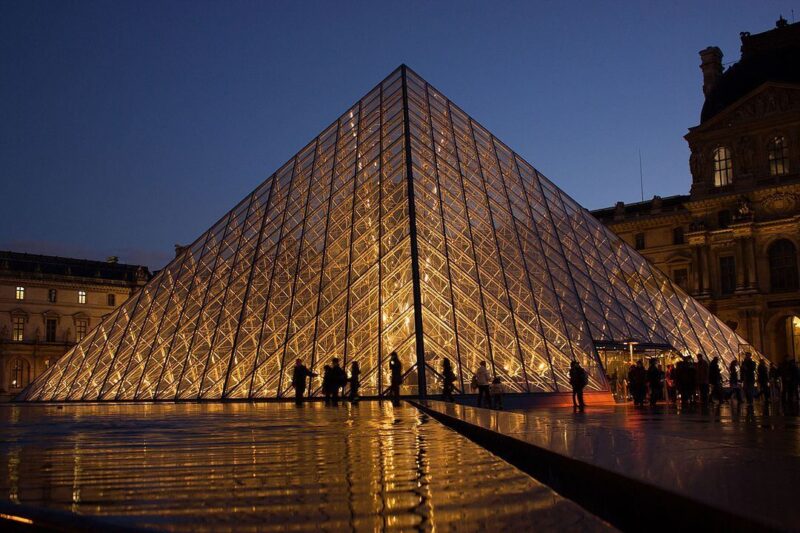Ask for a list of famous modernist architects, and I. M. Pei will no doubt be near the top. This Chinese-American architect is perhaps most celebrated for designing the Louvre Pyramid, but his portfolio boasts numerous iconic projects from around the world.

I. M. Pei was born on April 26, 1917, and grew up in Shanghai as part of a well-to-do family. As his father was a banker and Pei’s interests were in the arts, he declared, “I have cultivated myself” to describe his early development.
Pei gravitated toward gardens in Suzhou to the west of Shanghai, especially the 14th century Shizilin Garden, which would have a significant impact on his works.
When it came time for Pei to attend college, he opted to travel to the US to study architecture at the University of Pennsylvania before switching briefly to studying engineering at MIT. He remained at MIT, but quickly returned to studying architecture. Both colleges mainly taught Beaux-Artx, which did not impress Pei. Luckily for him, Le Corbusier paid a visit to MIT. Pei later said, “The two days with Le Corbusier, or ‘Corbu’ as we used to call him, were probably the most important days in my architectural education.”
I. M. Pei’s Design Philosophy
Le Corbusier was chief among Pei’s influences, as was Frank Lloyd Wright. While he leaned toward modernist styles and did not want to get bogged down by the conventions of the past, his works are infused with a blend of modernity and tradition.
Pei said, “Architecture is the very mirror of life. You only have to cast your eyes on buildings to feel the presence of the past, the spirit of a place; they are a reflection on society.”
Since he saw architecture as a mirror of life, Pei took a pragmatic approach to design. He explained, “The talk about modernism versus post-modernism is unimportant. It’s a side issue. An individual building, the style in which it is going to be designed and built, is not that important. The important thing, really, is the community. How does it affect life?”
Famous Works by I. M. Pei

The Herbert F. Johnson Museum of Art: Pictured above is the Herbert F. Johnson Museum at Cornell University in Ithaca, New York. The cantilevered design helps retain visibility of the Arts Quad and Cayuga Lake and also offers breathtaking views from above.
The Louvre Pyramid: This structure stands out in stark contrast to the French Renaissance buildings of the Louvre Palace. It has become one of the first things many people picture when they think of Paris.

East Building, National Gallery of Art: This distinctive structure sits on a trapezoidal site at the Mall in Washington D.C., and is defined by isosceles triangles. Its modern design mirrors its purpose, which is to house works of modern art. This places it in contrast to the neoclassical West Building, which houses traditional art.
Mesa Laboratory: Pei designed the Mesa Laboratory in Boulder, Colorado with a mixture of modern and Anasazi influences. The warm reddish hue of the bush-hammered concrete complements the colors in the landscape.
Rock and Roll Hall of Fame: Located in Cleveland, Ohio, the Rock and Roll Hall of Fame Building features a design that Pei said would “echo the energy of rock and roll.”

John F. Kennedy Library and Museum: Located in Boston, MA, this concrete and glass structure serves as a powerful architectural tribute to the memory of JFK.

Suzhou Museum New Wings: It is fitting that in 2006, Pei returned to his roots by completing a modernist museum in Suzhou, the setting that so inspired him in his youth. The result is a timeless fusion of traditional and modern architecture that looks toward the future while honoring the past.
If you enjoyed this post, you also may like to read more about the I. M. Pei-designed The Herbert F. Johnson Museum Of Art: A Window On The Landscape. And of course, don’t forget to follow us on Instagram, Facebook and Pinterest for more Mid Century Modern inspiration!












